Aboriginal Rock Art – A Brief Introduction

Over the years, we have heard many (white) Australians comment that they love travelling to Europe because there is so much more history there. We have probably been guilty of that ourselves.
But the reality is that Australia is home to the oldest living culture in the world, and some of its rock art is so ancient it pre-dates the last ice-age, and possibly the one before that.
THE AGE OF AUSTRALIA’S ROCK ART
Determining the age of rock art is difficult and indeed controversial. Often there are few traces of organic material on or near the art-works to enable accurate dating of the art itself. In one famous case (well, in rock art circles at least), the late expert on Aboriginal rock art of the Kimberley, Grahame Walsh, discovered a fossilised wasp-nest over the top of one art-work. The wasp nest has subsequently been dated to around 18000 years old, with the obvious implication that the art was at least that old, and possibly much older.
But let’s not get bogged down in the controversial world of the carbon dating and luminescence-dating systems now used. Anyone interested can consult the many academic papers on the issue. All I need say is that the rock art of Australia dates from extremely ancient times, possibly as far back as 40000 years; well before ‘recorded’ history, though the art is a record in itself. To stand in front of one of these works and contemplate the person creating the work so long ago fills me with wonder and questions – what were they like, how did they live, what was their culture, what were they attempting to portray in their work?
THE MEANING OF THE ART
The art has many meanings of course. Some is instructive – “this is the food you will find here”, or “this is a map of the region”. Some aims to teach hunting techniques, tracking, or how to search for local root crops. Some acts as a warning – “be careful, there are dangerous spirits nearby”. Others act as a tribal record, of genealogy and hierarchy. Others still serve to warn would-be visitors that “this place is off limits”, or set aside for ceremonial purposes. And finally, some appears to be simply an expression of the joy of life, such is the beauty and elegance of the work.
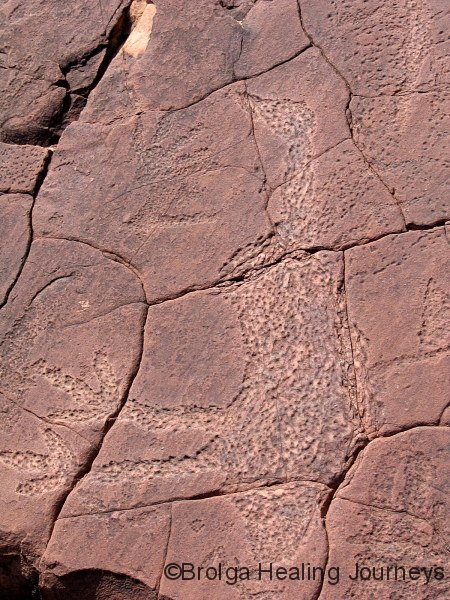
It is easy for the modern visitor to misinterpret the meaning of works, and for this reason I recommend that wherever possible, you visit rock-art sites with a traditional custodian of the site; someone who knows what the art means. A recent story illustrates this well. We had visited an art-site in Namadgi National Park, near Canberra. The site, at a place now known as Yankee Hat, contains ochre paintings of Australian fauna. It is tempting to interpret the paintings as a sign that these animals are found in the area (ie this is the local food source). And indeed that story is told on the interpretation signs at the site. But I recently read of an interview with a local elder, who said that while that is partly true, the real meaning of the art at that site was to show that tribes from different regions of the now ACT and NSW, for whom the animals represented their respective totems, would meet at his place for trade and ceremony.
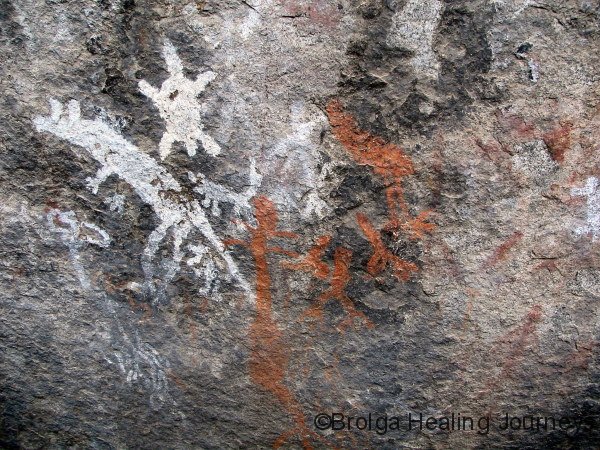
Some of the works are sacred, portraying creation stories, or were used in initiation ceremonies. And these works are found at sacred sites, places of ancient power. Modern humans blunder into these places without a thought, but traditionally such sites were approached with a sense of reverence, caution, respect and even fear. Traditional elders still do so today – calling to the spirits as they approach, and they remain at the site only as long as necessary, so as not to anger the spirits. To visit such a site with a traditional elder is an unforgettable experience.
Unfortunately, the meaning of some rock art has been lost. In some cases, such as the Gwion Gwion (Bradshaw) art of the Kimberley, the art is so old that knowledge of the people who created it and the art’s meaning has been lost in the mists of time. In fact, the Gwion Gwion (Bradshaw) art is quite a controversial area. For many years, it was reported that the modern Aboriginal peoples of the Kimberley dismissed this art (“rubbish art”), completely ignored it, or said that it had been painted long ago by a small bird with the blood from its broken beak. This last story may seem strange, but it is interesting to note that the only colour to have survived time and the elements is the deep red oche – a blood-like stain on the rock. It was suggested, by Grahame Walsh among others, that these art works may be the legacy of a civilization that pre dated modern Aboriginal settlement, and that this was why the art had no meaning for, or place in the stories of, the now ‘traditional’ people of the region. The totally different artistic styles of Gwion Gwion art, compared with the more recent Wandjina art of the current inhabitants, appeared to give some credence to Walsh’s view.
The view of Walsh and others like him had possible implications at the political and legal levels; if the Aboriginal people now living in those areas weren’t the original inhabitants of the region, then future native title claims might come into question. This was a nonsensical argument really, because the local people can be shown to have lived there continuously for thousands of years. In any event, a very interesting book published by the Kimberley Society in 2007 contains photographs from the late 19th and early 20th centuries showing Aboriginal people in ceremonial dress and ceremonial postures, highly reminiscent of those portrayed in the ancient Gwion Gwion images. The photographs were taken well before the current controversy ignited, so there can be no suggestion that history was being re-written to support the claims of the Kimberley’s Aboriginal people. When Aboriginal people came forth during the first decade of this century to claim that the Gwion Gwion images belonged to their tradition, cynics suggested that this was purely a political stunt. But those early photographs, to my mind, demonstrate that Aboriginal culture can indeed be traced to the ancestors who painted those Gwion Gwion images so long ago, even if present-day Aboriginals have no cultural recollection of the art-work.
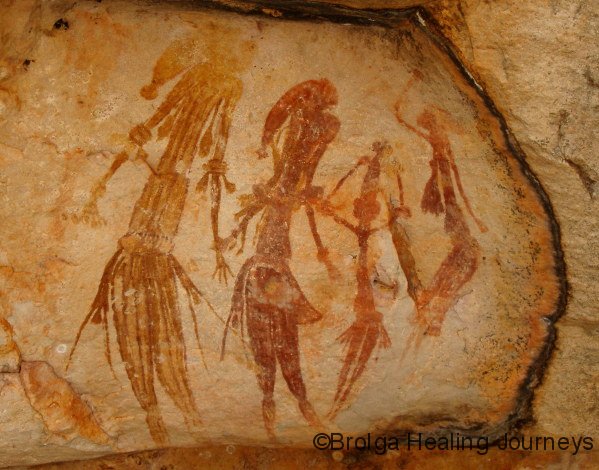
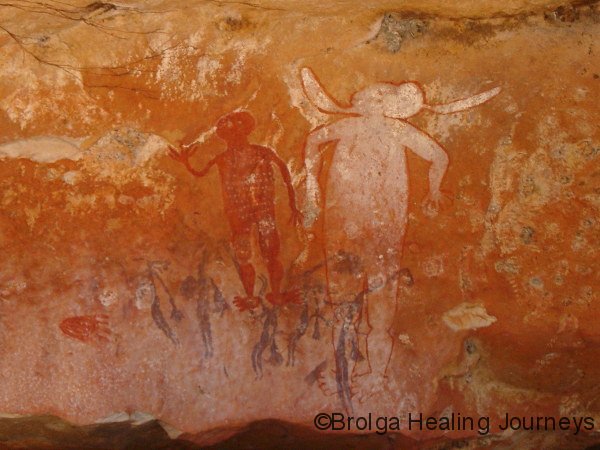
The meaning of the rock art of some other regions has been lost for more recent reasons. The destruction of the Aboriginal culture of an area has often been responsible for this loss. In some areas, such as the Kennedy Range National Park in the southern Pilbara region of Western Australia, the meaning of intricate images is now a mystery because no-one remains with the traditional knowledge to explain them. There are many arguments for maintaining traditional culture in Aboriginal society, the most compelling associated with restoring the well being and self esteem of the people concerned. I think this link with the past, to maintain a continuous and ancient culture, provides another powerful argument.
Often we have visited art sites unaccompanied, both because that is permitted and because traditional custodians are not always available to take you to a site. On those occasions we have followed a few simple rules – we never touch the art works, we treat the sites with the utmost of respect and, when in doubt, we don’t enter a site or photograph the site. And obviously, we would never take anything, other than photographs and memories, from any site. These guidelines are common-sense really, but unfortunately not everyone follows them. If we all treat the sites with respect and minimize our impact upon them, they will continue to provide inspiration for generations to come.
TYPES OF ROCK ART, REGIONAL DIFFERENCES
Some regions of Australia are well-known for their rock art. The Kimberley, with its stunning Wandjina ochre-paintings, and its elegant and enigmatic Gwion Gwion figures, is perhaps best known.
Arhemland in the Northern Territory (especially the west of that region) is another well known region for rock art. Art sites in Kakadu National Park are visited every year by tens of thousands of people.
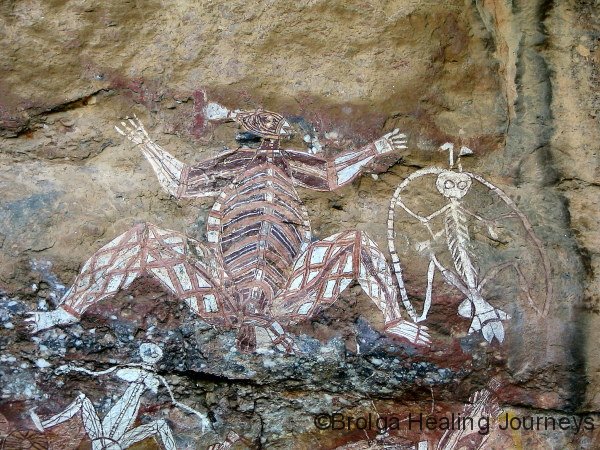
But travel through remote regions in other parts of the country and you will regularly encounter Aboriginal rock art. I am certain that Australia is home to an enormous number of art sites. Some are regularly visited, while others are so remote that they are rarely if ever visited. The late Grahame Walsh is said to have re-discovered many Gwion Gwion art sites during his life, and amassed over 1 million photographs of rock art in the Kimberley.
During our visits to sites around the country, I have been fascinated to notice stylistic similarities between regions, such as in the art from Mutawintji National Park in outback NSW and that of the distant Burrup Peninsula in the Pilbara region of Western Australia.
Some artistic themes and symbols are common to different regions – concentric circles usually represent the presence of waterholes or other
less obvious, water sources. Paintings or engravings of animal tracks generally show the presence of that animal in the area, although they may also form part of a larger creation story being told. Dancing figures often portray ceremonies.
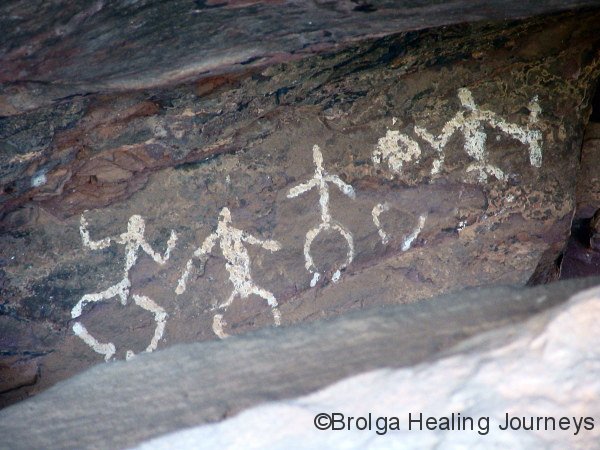
There are however many symbols unique to particular sites or regions, and these are often the most interesting. Some represent spirit beings (for example the Wandjina of the Kimberley, or the Mimi Spirits and Lightning Man (Namarrgon) of Arnhemland.
The extent and variety of art sites and subjects across Australia reinforce the feeling that there has been a long and widespread cultural tradition in this land.
There are two main types of rock art, ochre paintings and engravings (petroglyphs). In some rare instances, both forms are combined.
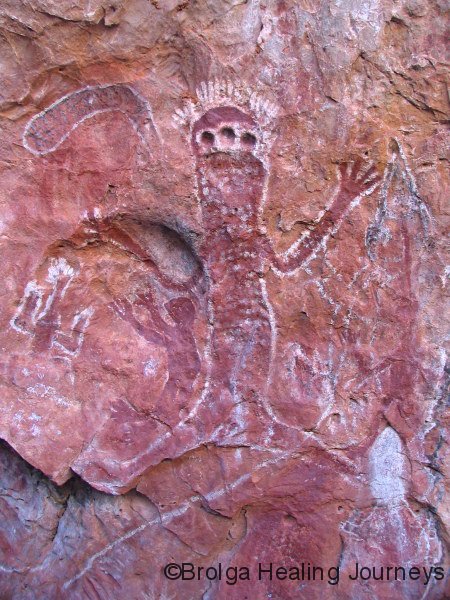
Perhaps the best known is the ochre painting, where rock, clay, sand or a mixture are made into a paint using water, saliva or animal fats, and applied to the rock. In some cases the ochre mixture was placed in the mouth and then sprayed over a hand placed on the rock, to create the well known hand stencil art-form.
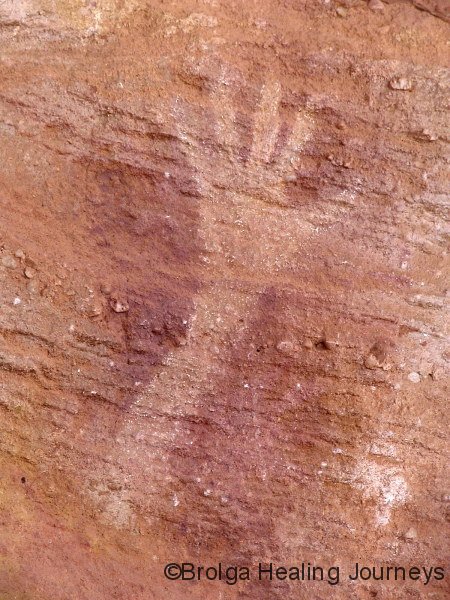
Traditionally, the colours of ochre-based artwork were ‘earthy’, and reflected the clays and soils in a region. Some high-quality ochres, or those with unusual colour, were traded between tribes. With the arrival of white settlers, other colours appeared in artworks, notably blue.
The other major art style is known as petroglyphs, where an image is chipped or ground out of the rock, using another rock or tool. These are the more durable type of art, for they last until the rock itself erodes away. This form of art is perhaps the most widespread across Australia.
Some of the petroglyphs consist only of a shallow outline of an image chipped into the rock, while others represent an enormous amount of work and artistic precision, with a whole panel chipped away, often from extremely hard surfaces.
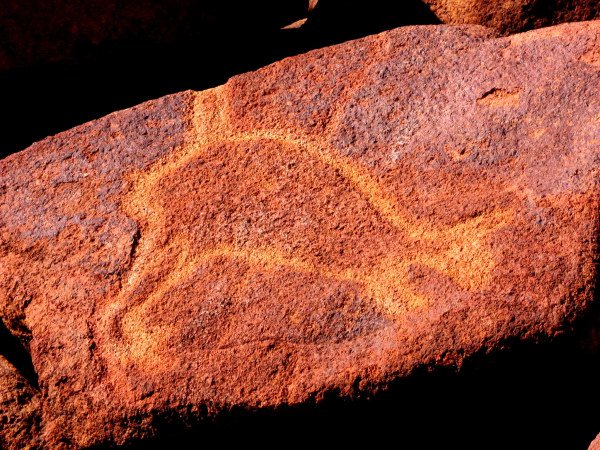

In many areas, rock art is to be found in caves or under rock overhangs, many of which were once used as shelter by the Aboriginals who created the art. In many cases the protected environment of these rock overhangs has aided the preservation of the art. Unfortunately, in relatively recent times, feral goats in outback NSW and South Australia have damaged art sites by sheltering under these overhangs and rubbing or scratching themselves against the rock.
In other areas, especially the Pilbara of Western Australia, petroglyphs are found in the open, on exposed boulders. The Burrup Peninsula provides the most dramatic example of these boulders, with enormous hills consisting of these boulders covered in rock art. The Burrup Peninsula is a treasure-house of rock art, with an enormous number of individual works; estimate range between 250,000 and 1 million for the number of art works in the region.
THE PHOTOGRAPHS
We have taken several thousand photographs of rock art across Australia. We will present some of these images in galleries relating to specific sites or regions. This will obviously involve a deal of work, so the galleries will be added to this site over the coming months.
Finally, some of you may wonder whether it is culturally appropriate for a non-Aboriginal to place photographs of Aboriginal Rock Art on the internet. I have thought long and hard about this myself and have decided that it is, depending upon circumstance and intention. The photographs here are not for sale – I certainly do not consider that it would be appropriate for me to benefit financially from someone else’s artistic creations, even those made thousands of years ago. And I have not posted any photographs of art where I know that to be secret/sacred. We have visited a number of art sites where photography was not allowed, and I have always respected that wish. I have put these photographs on the internet out of a sense of respect and love for them. My hope is that by seeing them more people will become aware of their beauty, variety and antiquity, and maybe share a little of my sense of awe for them. Too few know about the cultural treasure of Australia’s Aboriginal Rock Art.
Wow!! I will have a proper read through this later but these photos are amazing! The one there from Yankee Hat at Namadgi is where we are concluding the roo story I have been working on for the past six months.
Thanks Carly. Yes – your post on your filming at Yankee Hat led me to the information about the deeper meaning of the rock art there. So you are now part of the world of rock art!
Thank you so much for this wonderful photos and explaining!
I´m from europe and we have some very amazing stone age caves with wunderful pictures, but the mimi-ghost from the aboriginal culture are something so special, i dont think you can find something like this somewhere else. I love their art so much, and i´m a very proud owner of a didgeridoo,too.
Australia is a very, very atractive holidayplace for us european